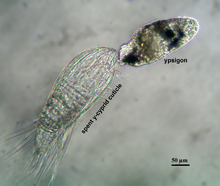Facetotecta is a poorly known subclass of thecostracan crustaceans.[1] The adult forms have never been recognised, and the group is known only from its larvae, the "y-nauplius" and "y-cyprid" larvae.[2] They are mostly found in the north Atlantic Ocean, neritic waters around Japan,[3] and the Mediterranean Basin, where they also survive in brackish water.[4]
| Facetotecta | |
|---|---|

| |
| A Y-psigon escaping from its y-cyprid | |
| Scientific classification | |
| Domain: | Eukaryota |
| Kingdom: | Animalia |
| Phylum: | Arthropoda |
| Class: | Thecostraca |
| Subclass: | Facetotecta Grygier, 1985 |
| Family: | Hansenocarididae Itô, 1985 |
| Genus: | Hansenocaris Itô, 1985 |
| Species | |
|
See text | |
The German zoologist Christian Andreas Victor Hensen first collected facetotectans from the North Sea in 1887, but assigned them to the copepod family Corycaeidae; later Hans Jacob Hansen named them "y-nauplia", assuming them to be the larvae of unidentified barnacles.[5] More recently, it has been suggested that, since there is a potential gap in the tantulocarid life cycle, y-larvae may be the larvae of tantulocarids. However, this would be "a very tight fit", and it is more likely that the adult forms have not yet been seen.[2] Genetic analysis using 18S ribosomal DNA reveal Facetotecta to be the sister group to the remaining Thecostraca (Ascothoracida and Cirripedia).[6]
Y-nauplii are 250–620 micrometres (0.010–0.024 in) long,[2] with a faceted cephalic shield, from which the group derives its name.[7] The abdomen is relatively long, and also ornamented.[2] In common with other thecostracans, Facetotecta pass through five naupliar instars before undergoing a single cyprid phase.[5]
The presence of a distinctive cyprid larva indicates that the Facetotecta is a member of the Thecostraca. A number of species have been described on the basis of a y-cyprid alone.[8] As in barnacles, the cyprid is adapted to seeking a place to settle as an adult. It has compound eyes, can walk using its antennae, and is capable of producing an adhesive glue.[9]
In 2008, a juvenile form was artificially produced by treating y-larvae with the hormone 20-hydroxyecdysone, which stimulated ecdysis and the transition to a new life phase. The resulting animal, named the ypsigon, was slug-like, apparently unsegmented, and limbless.[9][10]
While they have never been seen, the adult facetotectans may be endoparasites of other animals, some of which could be inhabitants of coral reefs.[11]
Eleven species are currently recognised,[3] while one species which is assigned to Hansenocaris – H. hanseni (Steuer, 1905) – is of uncertain affinities:[5]